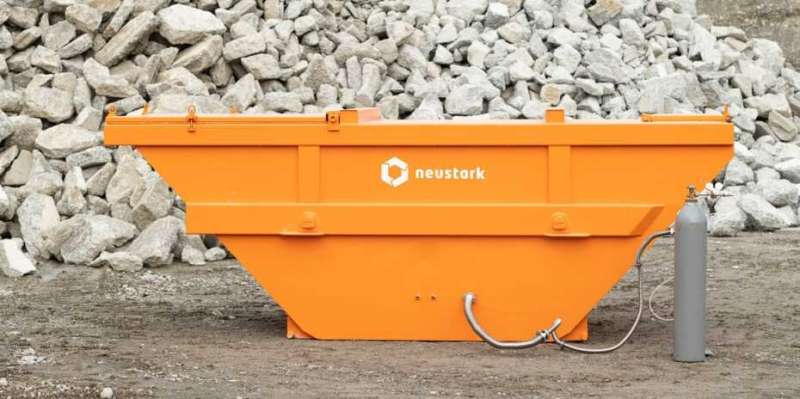Binding carbon dioxide using broken concrete

Thanks to technology from ETH spin-off Neustark, concrete recycling plants can store carbon dioxide over the long term.
The two young entrepreneurs and founders of the ETH spin-off Neustark couldn't be more different, but they work very well together. Johannes Tiefenthaler is a doctoral student at the Department of Mechanical and Process Engineering, working on the next generation of technology for the mineralisation of carbon dioxide.
Valentin Gutknecht, meanwhile, is a business economist and handles both the ever-growing team and the operational aspects. They were brought together by their shared vision of implementing a climate-positive business idea in reality.
Using insights in practice
"There is a lot of research being done on construction-related topics, but the industry has only achieved small reductions in emissions so far, because many of the findings are simply put in a drawer and never used," says Tiefenthaler. "I would like to use the energy I'm putting into my doctorate to make a difference."
Tiefenthaler had already started looking at various ways to make carbon dioxide react with mineral materials and bind it as limestone during his Master's degree.
There are enough mineral materials on Earth to bind hundreds of billions of tons of carbon dioxide, but because these materials—such as magnesium silicate—are not particularly reactive, they have to be heated up to 700°C first, says Tiefenthaler. In contrast, concrete granulate has proven to be highly reactive due to the huge total surface area of the numerous particles, each just a few millimeters in size: even without pretreatment, the broken concrete forms very stable chemical compounds with the carbon dioxide.
Refined properties of demolition material
What's particularly special about Neustark's technology is that it binds CO2 in the pores and on the surface of concrete granulate as limestone. This upgraded granulate can then be mixed into fresh concrete as a replacement for sand and gravel. The upgraded granulate means that less cement is required—while the properties remain the same.
"I'm very excited by the fact that this solution isn't just coming in five or ten years—it's available now," says the second young entrepreneur, economist Valentin Gutknecht. He found time to talk while on his way to the Kästli concrete facility near Bern, where Neustark's pilot plant is gradually being brought into operation.
Before founding the company, Gutknecht helped to manage marketing and sales for the ETH spin-off Climeworks, a pioneer in the removal of carbon dioxide from ambient air. With Neustark, the main challenge is juggling all the different areas involved, says Gutknecht. They not only have to have a handle on the properties of the concrete, but also navigate the convoluted paths of CO2 certification.
"We began by interviewing the CEOs of ten different concrete facilities to find out where the problems lie," explains Gutknecht. "We then used money from private investors and public funding to develop the first small prototypes."
They have chosen a container-based solution for now, says Tiefenthaler. In a project supported by the Federal Office for the Environment and the Swiss Climate Foundation, they now aim to demonstrate the value added along the whole value creation chain: the plan is for the carbon dioxide to be sourced from a biogas separation plant at the Arabern wastewater treatment facilities in Herrenschwanden. Neustark will then treat the demolished concrete in its pilot plant using this carbon dioxide (liquefied for transport).
Avoiding emissions—and even reversing them
Cement production worldwide releases around four times as much carbon dioxide into the air as global air traffic. As Neustark's technology helps to reduce the amount of cement required in construction, it therefore also improves its carbon balance, because some of the emissions from production can be avoided. But Gutknecht and Tiefenthaler both highlight an additional aspect: with their trick of capturing carbon dioxide from the air—to plug it into the pores of the concrete granulate and bind it there sustainably as limestone—they can even reverse CO2 emissions.
"There are very few technical approaches for real negative emissions," says Tiefenthaler. The use of these approaches has so far been limited, in particular because convincing incentives and business models are lacking. "In this respect, our approach is unique because we show that added value can be created by binding carbon dioxide. And that negative emissions don't just raise costs—they can actually provide economic benefits," says Gutknecht.
Provided by ETH Zurich



















